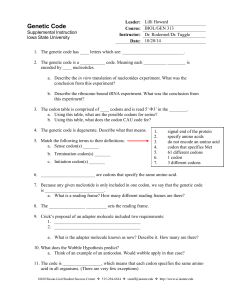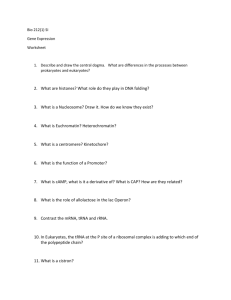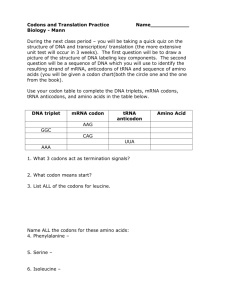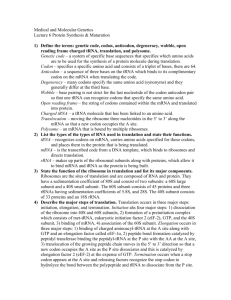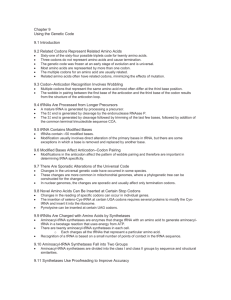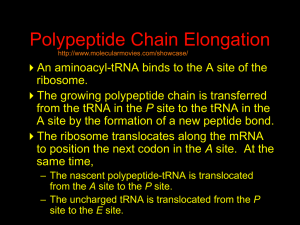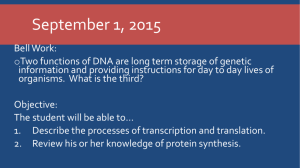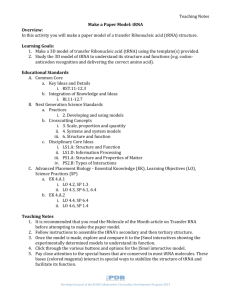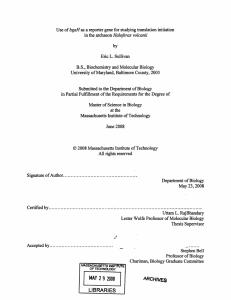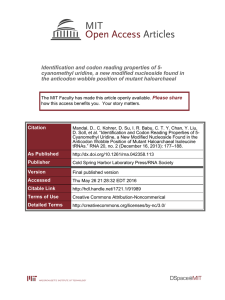Evolution of the Genetic Codes
advertisement
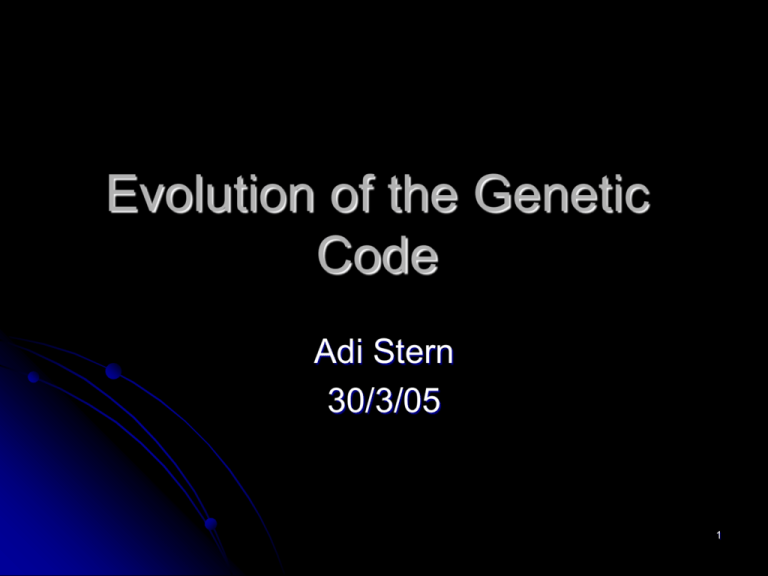
Evolution of the Genetic Code Adi Stern 30/3/05 1 Outline 1. 2. 3. 4. Introduction – the translation mechanism Cracking the code Genetic code(s) The 3 theories of evolution 2 Introduction - translation 3 tRNA Matches amino acids to codons in mRNA 4 Aminoacyl-tRNA synthetase Attach amino acids to tRNA Most cells: 20 aminoacyl synthetases Bacteria: less than 20, some “incorrectly” attached tRNAs are modified High-accuracy defining stage 5 tRNA 61 codons → < 61 different tRNAs: human: 48 different tRNAs (anticodons) bacteria: 31 different tRNAs (anticodons) BACTERIA EUKARYOTES Wobble (codon base 3) (anticodon base 1) Wobble (codon base 3) (anticodon base 1) U C A G A,G or I G or I U or I C or U U C A G G or I G or I U C 6 CRACKING THE CODE 1953: DNA structure (Watson and Crick) 1961: the genetic code (Matthaei and Nirenberg) 7 …in between … George Gamow – a Russian physicist, is excited by the double helix The “RNA tie club” Crick (Tyrosine) Watson (Proline) 8 The Diamond code (Gamow,1954) Problems: (1) overlapping code, restricts aa neighbours. 9 (2) translation in ctyoplasm Comaless code (Crick, 1958) No commas (proved correct) Only 20 of 64 codons are meaningful – all other are skipped. No frameshift! a codon such as AAA is meaningless ABA ABB ACA BCC aa1 aa2 ? “The most genius theory proved wrong…” aa3 aa4 Does not exist! 10 Cracked! A Cell-free system was devised in which UUUUUUUUUUUU was translated (=FFFFFFF) CCCCCCCCCCCC was translated (=PPPPPPP) and so on… “Almost disappointing…” 11 The standard genetic code 12 The Universal Genetic Code? Found in “all” organisms Change in the genetic code would affect all coding proteins lethal. “The frozen accident” (Crick, 1968) 13 But … there isn’t only 1 code, but 16! 14 The code can evolve. Codon assignments are non-random 15 16 Adaptation 17 Reduces the effect of translation error Reduces the effect of point mutation … but – these are chemical considerations 18 Code optimality Compare the code(s) with random alternatives 19 Standard genetic code BUT … This works when the criteria is: - polarity - PAM distance But it doesn’t work with: - size + there is a lot of debate on the validness of these methods (e.g. DeGulio 2000) HOW IS CHANGE POSSIBLE? 20 Codon Capture The ‘codon capture’ theory (Osawa-Jukes 1988): Following GC content pressure on the genome, tRNAs disappear and reappear with a different recognition. 21 Codon-Capture Model Supposed model in Mycoplasma capricolum: 1. TGG (Trp), TGA (Stop) AT pressure reduced 2. TGG (Trp), AT pressure TGA → disappears, replaced for instance by TAA (Stop) 4. TGA reappears, unrecognized 3. release factor (TGA) disappears (no selective pressure) 5. tRNA (TGG) for Trp duplicates, and mutates to recognize TGA. Now TGA codes for Trp 22 Evidence in favour In Mycoplasma capricolum, tRNA (TGG) and tRNA (TGA) are on the same operon. In related bacteria – the codon TGG has entirely disappeared…(replaced entirely by TGA) 23 The ambiguous intermediate Codons did not disappear – tRNAs which are ambiguous, led to fixation of one tRNA + codon in one species an to another in another species Supporting evidence: E.Coli UAG translates to stop, Trp or selenocysteine. Replacements of all codons by another a.a. are not necessarily lethal! Experiment: partial replacement of Ile by Cys in E.Coli resulted in only low loss in fitness! (Doring and Marliere, 1998) 24 Genome streamlining hypothesis Pressure to minimize the genome of mitochondria (or other) obligatory parasites leads to reassignment of codons. Transfer of genes to nuclear genomes → less constraint on the mitochondria genome. 25 History – a slowly growing code Initial, limited set of amino acids. Newly introduced amino acids according to similar biosynthetic path. New amino acids did not make drastic change in the protein. Theory: First base – similar biosynthetic pathway Second base – similar aa properties 26 tRNA, aa-tRNA-Synthetase phylogenies aa-tRNA-Synthetases phylogeny supports the ‘biosynthetic theory’ Phylogenies of tRNA and aa-tRNASynthetases are non-congruent… So maybe all this happened within the Last Common Ancestor of all organisms 27 Summary-change in genetic code Primordial code: expansion of code from few to 20 a.a.’s tRNA and aa-tRNA-Synthetases are invented → this enables codon swapping and code optimization Ambiguity enables change Most of these changes – in relatively ‘simple’ organisms. 28
